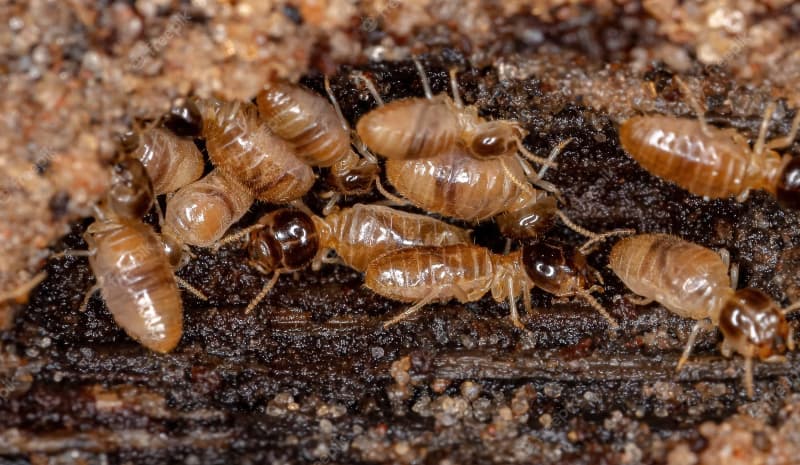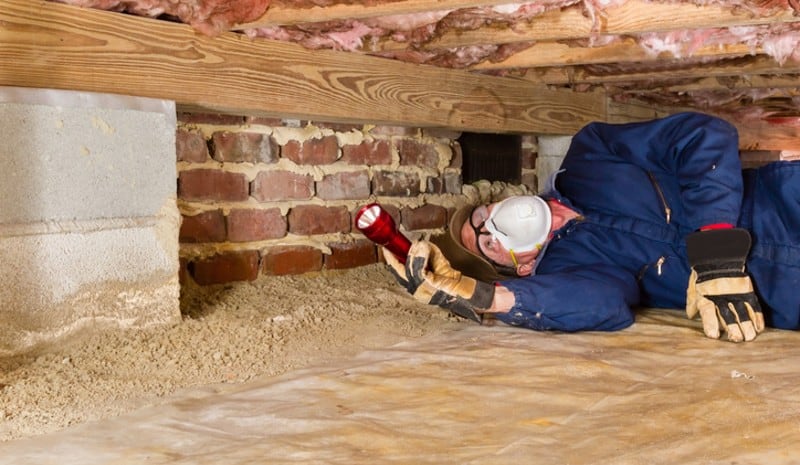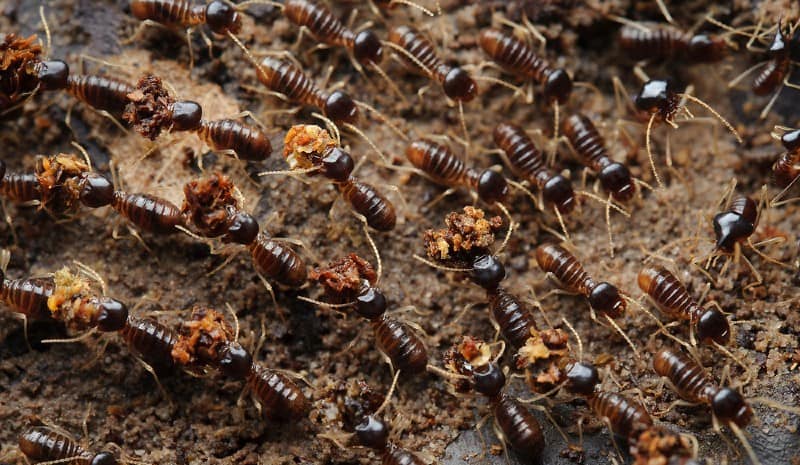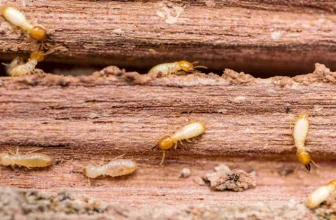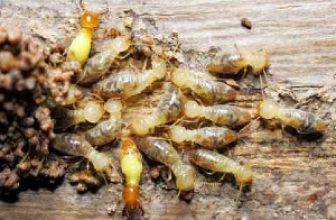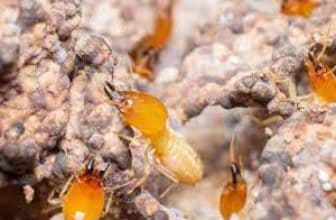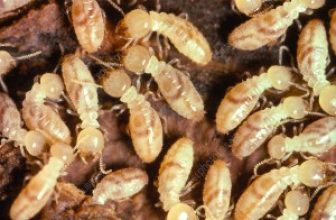Types of Termite Feeding Patterns
Understanding the different types of termite feeding patterns is an essential part of controlling and preventing termite infestations. Termites have unique dietary requirements compared to other insects and animals. They depend on cellulose from wood and other plant materials to meet their nutritional needs. But different termites favor different types of wood and other cellulose-containing materials. This variability is largely due to their gut microbes that aid in digesting cellulose.
The types of wood and other cellulose-containing materials that termites prefer can also vary depending on the gut microbes they possess. However, cellulose will always be their primary source of nutrition. Termite feeding habits vary so much that they can pose a challenge to termite control professionals.
Understanding the various termite feeding patterns and their specific dietary needs is critical in managing termite infestations. Homeowners and pest control experts must be mindful of the type of wood and construction materials used when building structures. Professional inspections should be conducted to identify areas of infestation, enabling the implementation of appropriate treatment measures.
Subterranean Termite Feeding Habits
Subterranean termites are the most destructive type of termites, causing damage to buildings and structures all over the world. Their feeding habits play a crucial role in their survival and reproduction. Subterranean termites get their nutrition from cellulose, the main component of plant and wood materials. However, they cannot digest cellulose on their own and rely on gut microbes to break it down into simpler compounds. These microbes also help termites process other nutrients, such as nitrogen and carbon.
Subterranean termites also require moisture to survive, which is why they build mud tubes in the soil that connect to their food sources. These tubes provide a humid environment that keeps them from drying out. They feed on a variety of wood sources, including live and dead trees, logs, stumps, and construction timber. They are especially attracted to wood that has been softened by decay or moisture.
Subterranean termites forage in a systematic and organized manner. They send out scouts to search for new food sources, and once they identify a suitable location, they recruit more workers to consume it. This feeding behavior can cause severe damage to wood structures, as they can completely consume a piece of wood from the inside out, leaving only the outer layer intact. This makes it difficult to detect an infestation until it has already caused extensive damage.
To prevent subterranean termite infestations, it’s important to take steps to reduce moisture in the environment, as well as to remove or treat any potential food sources. This includes fixing leaky pipes and faucets, installing proper drainage systems, and replacing any water-damaged wood. It’s also important to seal any cracks or gaps in the foundation and walls of the structure to prevent termites from entering.
Dampwood Termite Feeding Habits
Dampwood termites are the largest type of termites, ranging in size from ½ to ⅝ of an inch. They primarily live and feed on damp and decaying wood, and therefore are more likely to infest wood that has been in contact with water. This makes them less of a structural threat to homes, as they tend to prefer logs, stumps, and fallen trees. However, if there is any damp wood within a building, such as in crawlspaces or attics, they will not hesitate to infest it.
Dampwood termites do not need contact with soil like subterranean termites do. They are able to get all the moisture they need from the wood they feed on, and they don’t construct mud tubes because of this. Their feeding habit involves consuming the softer spring wood and leaving the harder summer wood behind. This creates a distinct pattern of feeding damage that can be used to identify an infestation. The damage they cause is generally less severe than that of subterranean termites. However, it can still weaken the integrity of the wood structure over time.
Dampwood termites also have unique biology in that they have a lower reproductive rate than other termites. This means that the colony size is typically much smaller, with only a few hundred individuals. However, they take longer to reach maturity, with some workers taking up to five years to mature. This can make control more difficult, as it takes longer for the colony to be large enough to be noticeable.
It is important to note that dampwood termites are not typically found in regions with a dry season or a cold winter, as they require a consistently moist environment to survive. Homeowners in these regions are more likely to encounter subterranean or drywood termites.
Termite wood relationship can also be a factor in controlling dampwood termites. Choosing wood that is less likely to retain moisture and decay, such as treated lumber or heartwood, can reduce the likelihood of an infestation. Homeowners can also use chemical treatments to protect against dampwood termite infestations.
Drywood Termite Feeding Habits
Drywood termites are one of the three main types of termites, and are more commonly found in tropical or subtropical regions. Unlike subterranean termites which rely on soil, drywood termites can live and nest in dry wood, which makes them harder to detect and control. They are able to feed on any cellulose material, including dead trees, fence posts, and homes.
One of the telltale signs of a drywood termite infestation is the piles of tiny fecal pellets, which they create as they excavate galleries in the wood. These pellets are hexagonal in shape, dry, and about 1 mm long. Drywood termites can also cause significant damage to timber structures, and can chew through plaster, plastic, and rubber.
Drywood termites can survive by consuming cellulose without the assistance of gut microbes, unlike subterranean termites, which rely on these microbes to break down cellulose in their gut. This makes drywood termites more efficient in digesting their food, and allows them to extract more nutrition from infested wood.
Controlling drywood termites can be challenging, as their colonies are usually smaller and more dispersed than subterranean termites. Additionally, since they don’t need soil, it’s harder to establish a perimeter barrier. Fumigation is often the most effective control method for drywood termites, as it can reach all areas of the infested structure or furniture. However, other methods like heat treatment and electro-gun treatment may also be used.
Preventing drywood termite infestations can be achieved through structural modifications and landscaping considerations. Ensuring that all wood in your home is treated or stained, and that there are no cracks or gaps in the structure. Sealing all entry points like windows, doors and vents, reducing moisture levels in crawl spaces, and storing firewood away from the house can also help prevent infestations.
Significance of Termite Feeding Patterns for Control
Understanding termite feeding patterns is crucial for effective control and prevention of termite infestations. Termite damage can be extensive, leading to costly repairs and structural instability. By understanding the different feeding patterns of termites, pest control professionals can develop targeted strategies that ensure complete eradication of termite colonies while minimizing the use of harmful chemicals.
How Understanding Feeding Patterns Benefits Termite Control
Understanding termite feeding patterns is crucial for effective termite control strategies as it helps in:
- Targeting infestations: By identifying the species and feeding habits of termites in a specific area, it becomes easier to target the infestation with the right control methods. For example, subterranean termites feed on cellulose material found in soil and wood, while drywood termites feed exclusively on dry wood. Knowing this information allows us to use different treatment options for each type of termite infestation.
- Enhancing baiting and monitoring systems: Baiting systems are designed to work with the feeding behavior of termites. Different species of termites feed on different food sources, and thus require different baits. By knowing the feeding habits of termites in the area, we can use the right bait for effective control. Additionally, monitoring systems can be strategically placed based on the feeding patterns of the termites.
- Preventing future infestations: Knowing the feeding habits of termites can help in preventing future infestations. For instance, dampwood termites love moist environments, so reducing moisture levels in and around a house can help prevent infestations. In contrast, drywood termites thrive in dry wood, so storing firewood away from the house and keeping wooden surfaces dry can help prevent infestations.
Understanding feeding patterns can aid in overcoming challenges in termite control:
- Termite behavior: Termites can detect and avoid chemical barriers set up around a property. By knowing the feeding behavior of termites, pest control professionals can use alternative control methods that will not alert termites, resulting in more effective control.
- Location of infestations: Different feeding patterns can result in different locations of termite infestations. Subterranean termites may be found in soil, while drywood termites are often found within the wooden structures of a building. Knowing the feeding habits of termites can help locate the source of infestation, making it easier to control.
Tools and Strategies for Monitoring and Controlling Termite Feeding Patterns
When it comes to effectively monitoring and controlling termite feeding patterns, there are a variety of methods available to homeowners and pest control professionals alike.
Baiting and Monitoring Systems: One popular method is the use of baiting and monitoring systems. These systems work by placing bait stations near areas where termite activity has been detected. The bait inside the stations is typically laced with an insect growth regulator, which slowly kills the termites over time.
As termites feed on the bait, they leave behind chemical markers that attract other members of their colony to the station. This allows for the entire colony to be targeted, rather than just the individual termites that happen to feed on the bait. Regular monitoring of the bait stations is necessary to ensure that termite activity is being effectively controlled.
Soil Treatments and Barrier Applications: Another commonly used method involves the application of termiticides to the soil surrounding a structure, creating a barrier that termites cannot pass through. This type of treatment is typically done during the construction phase of a building, but can also be applied in established homes and buildings.
Soil treatments can be applied in a variety of ways, including trenching, rodding, and drilling. Once the termiticide has been applied, it is important to monitor the treated area regularly to ensure that the barrier remains effective.
Wood Treatments and Fumigation: For established infestations, wood treatments and fumigation are often necessary. These methods involve the use of high-powered chemicals that are designed to kill termites on contact.
Wood treatments involve the direct application of chemicals to infested wood, either by injection or surface spray. Fumigation, on the other hand, involves the use of a gas that penetrates all parts of a structure, including walls, floors, and ceilings. This method is typically reserved for severe infestations.
Best practices for Preventing Termite Infestations: Of course, the best way to control termite feeding patterns is to prevent infestations in the first place. Homeowners can take a number of steps to reduce their risk of a termite problem, including:
– Keeping wood and other cellulose-based materials away from the foundation of the home.
– Regularly inspecting the home for signs of termite activity.
– Ensuring that the home’s exterior is properly sealed and maintained.
– Consistently monitoring the moisture levels inside the home.
– Scheduling regular professional inspections and treatments.
By staying vigilant and taking preventative measures, homeowners can reduce their likelihood of dealing with a termite infestation in the future.
Baiting and Monitoring Systems
A highly effective method for monitoring and controlling termite feeding patterns is through the use of baiting and monitoring systems. This strategy involves placing bait stations around the perimeter of a structure or in areas where termite activity has been detected. These bait stations contain specially formulated bait that is designed to attract termites. Once a termite begins to feed on the bait, it will carry it back to the colony where it will be shared with other termites, ultimately leading to the eradication of the colony.
One of the key benefits of baiting and monitoring systems is that they are non-invasive and do not require the use of harmful chemicals. This makes them an ideal choice for environmentally conscious homeowners and businesses. Additionally, baiting and monitoring systems are highly effective, with studies showing that they can eliminate up to 90% of termite colonies in just a few months.
It is important to note that baiting and monitoring systems require regular monitoring and maintenance in order to be effective. This includes inspecting the bait stations on a regular basis, replacing the bait as needed, and making any necessary adjustments to the placement of the stations in order to optimize their effectiveness.
While baiting and monitoring systems are highly effective for controlling certain types of termite feeding patterns, they may not be as effective for other types. For this reason, it is important to work with a professional pest control company that can properly identify the type of termites present and recommend the best course of treatment.
Baiting and monitoring systems are an excellent choice for homeowners and businesses looking for a safe, effective, and environmentally friendly way to control termite feeding patterns. By working with a professional pest control company and implementing a comprehensive termite control strategy that includes baiting and monitoring systems, it is possible to effectively eliminate termite colonies and prevent future infestations.
Soil Treatments and Barrier Applications
When it comes to controlling termites, soil treatments and barrier applications are commonly used. These methods involve creating a chemical barrier around a structure or property, which serves to either repel or kill termites that try to cross it.
Soil treatments are usually done before construction, during the pre-construction phase. A termiticide is applied to the soil where the foundation will be built. This is done to prevent termites from entering the structure from the ground. The chemical is absorbed by the soil and acts as a barrier against termites.
Barrier applications on the other hand, can be done during construction or after a structure has been built. Barrier applications involve creating a continuous barrier of termiticide around a structure. This is usually done by drilling holes in the soil around the foundation and then injecting termiticide into them.
There are two types of barrier applications used in termite control – repellent and non-repellent. Repellent barriers keep termites away by emitting a strong odor or repulsive chemical. Non-repellent barriers, on the other hand, do not repel termites, but instead, they are designed to kill them upon contact.
Another application that can be used besides soil treatments and barrier applications is a baiting and monitoring system, which can help detect and control termite activity. Baiting and monitoring systems involve placing baits with slow-acting insecticides in areas where termites are already active. When the termites consume the bait, they take it back to the colony, effectively killing the entire population.
It’s important to note that when using soil treatments and barrier applications, it’s best to consult with a professional pest control company. They have the experience and expertise to ensure that the treatment is applied correctly and effectively. Additionally, regular inspections and maintenance are necessary to ensure that the barrier remains intact.
Wood Treatments and Fumigation
When it comes to dealing with termite infestations, wood treatments and fumigation are two commonly used methods. Wood treatments involve applying chemicals directly to the wooden structures in your home. These chemicals can either repel or kill termites, preventing them from causing further damage.
The Importance of Wood Treatments
Wood treatments are particularly useful in situations where localized infestations are identified, and the damage is still minimal. By treating the affected area directly, you can stop the termites from continuing to feed and causing further damage.
The Process of Wood Treatments
Wood treatments usually involve drilling holes into the affected wooden structures and injecting the chemicals directly into the wood. The chemicals used in these treatments can vary, but they are typically insecticides or fungicides that can protect the wood against further damage or decay.
Fumigation as a Last Resort
Fumigation is a more drastic measure that is typically reserved for severe infestations. This method involves tenting your entire home and filling it with toxic gas. The gas penetrates all the wooden structures and kills any termites present.
Although effective, fumigation can pose serious health risks to humans and pets if not done properly, which is why it should only be performed by licensed professionals who are trained in the use of these chemicals.
Conclusion
In conclusion, understanding termite feeding patterns is crucial for effective termite control. Termites can cause significant damage to structures and properties, which can be costly to repair. Therefore, it is necessary to have an effective termite control plan in place to prevent and manage infestations.
Feeding patterns play a vital role in termite biology and behavior, and different species of termites have unique feeding habits that must be identified and understood. Knowing the feeding patterns of termites allows for the development of more effective control strategies, which can better target and manage termite populations.
There are various tools and strategies available for monitoring and controlling different feeding patterns, such as baiting and monitoring systems, soil treatments, barrier applications, wood treatments, and fumigation. However, it is important to note that controlling termite populations can be challenging, and professional assistance may be necessary for the best results.
Prevention is always the best strategy for managing termite infestations, and regular professional inspections and treatments can help identify and address potential issues before they become severe. Additionally, structural and landscaping considerations can also help prevent termite infestations by reducing their access to potential food sources and limiting moisture build-up.
In summary, understanding and managing termite feeding patterns is a critical component of effective termite control. By implementing the best practices for prevention and developing a comprehensive control plan, property owners can protect their investments and ensure long-lasting termite management.
Frequently Asked Questions
1. How do termites cause damage to a structure?
Termites feed on cellulose found in wood and other materials like paper, cardboard, and fabric. Over time, this can weaken the structure and cause extensive damage.
2. What are the signs of a termite infestation?
Signs of termite infestation may include mud tubes, discarded wings, and wood that sounds hollow when tapped.
3. What are the different types of termite feeding patterns?
The three types of termite feeding patterns are subterranean, dampwood, and drywood. Each species feeds on different types of wood and has unique habits.
4. How can understanding termite feeding patterns benefit termite control?
Understanding the feeding patterns of different types of termites can help pest control professionals better target their efforts and choose the most effective treatment methods.
5. What are some challenges in controlling different termite feeding patterns?
Some challenges in controlling different termite feeding patterns may include difficulty in locating the source of the infestation and choosing the appropriate treatment method based on the species.
6. What are some tools and strategies for monitoring and controlling termite feeding patterns?
Tools and strategies for monitoring and controlling termite feeding patterns may include baiting and monitoring systems, soil treatments and barrier applications, and wood treatments and fumigation.
7. How can regular professional inspections and treatments prevent termite infestations?
Regular professional inspections and treatments allow for early detection of termite activity and can prevent infestations from becoming established or spreading.
8. What structural and landscaping considerations can help prevent termite infestations?
Some structural and landscaping considerations that can help prevent termite infestations include ensuring proper drainage, removing sources of moisture, and using termite-resistant materials for construction.
9. Can termite control be DIY?
While there are DIY termite control methods available, it is generally recommended to seek professional pest control services to properly identify and treat termite infestations.
10. How can I avoid unintentionally attracting termites to my property?
Avoid unintentionally attracting termites to your property by keeping piles of wood and debris away from the structure, trimming trees and shrubs away from the house, and fixing any leaks or standing water sources.
References
Contents
Why You Should Trust Pest Control Hacks?
We know that pests are nasty neighbors, and it can take months to eliminate them without the right approach. Our experts use their own experience to compile articles and guides that are introductory and informative. Our authors’ opinions are independent and based on the results of practical testing of pest control tools. We do not notify manufacturers of testing of their products and do not receive payment from them for posting their items. Also, our texts are never submitted to company representatives for proofreading before placement. On the site, you will find exclusively objective ratings and reviews.

